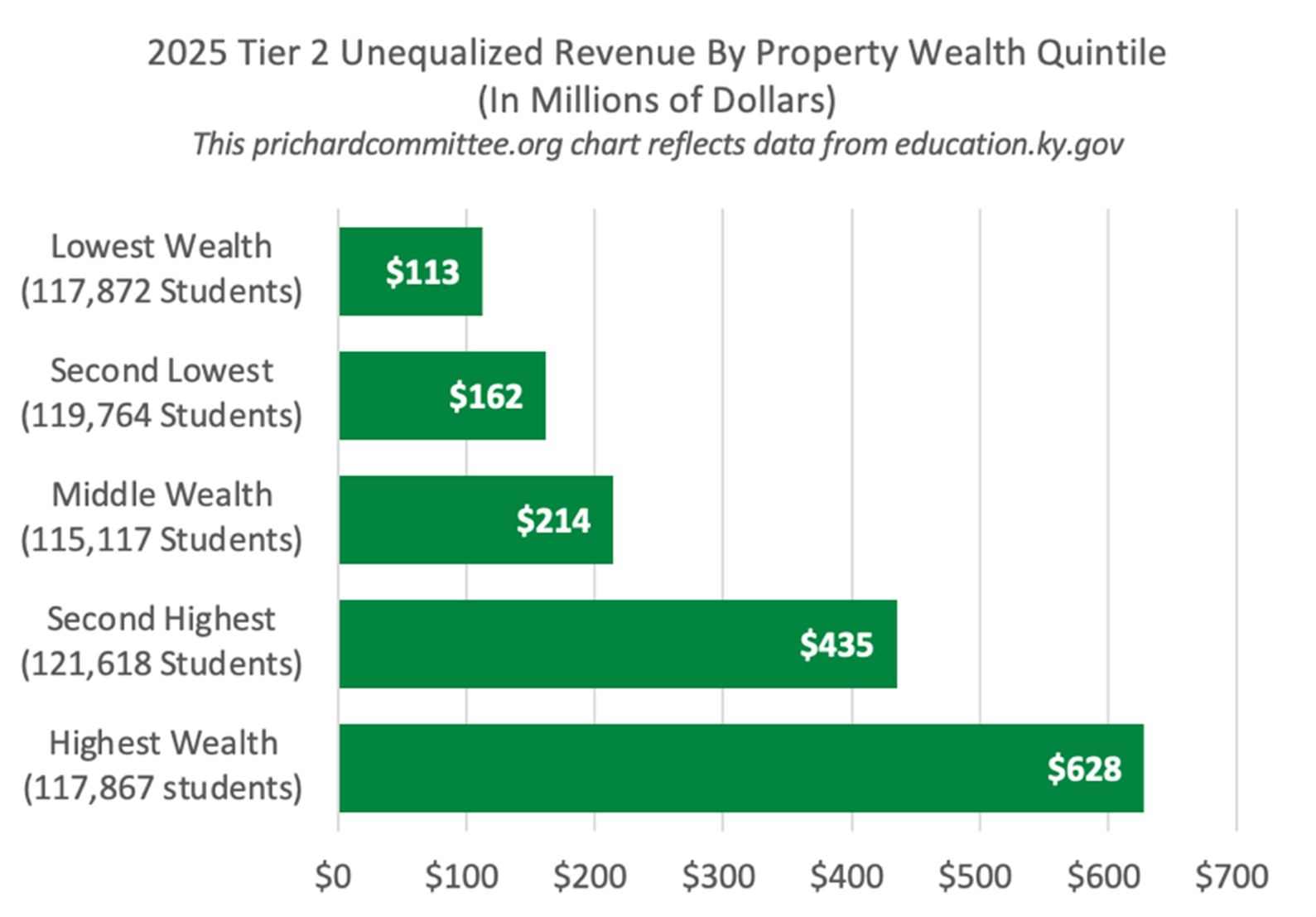HOW HAS SEEK FUNDING SHIFTED SINCE 2008?

Since 1990, SEEK (short for Support Education Excellence in Kentucky) has been the Commonwealth’s main mechanism for funding our common schools. From 2008 to 2025:
- Local contributions to SEEK rose rapidly
- State funding grew much more slowly
- Combined funding did not keep up with inflation, growth in attending students, growth in students with added needs, or growth in transportation costs
In this post, we’ll offer brief background basics on the SEEK formula, and then break down changes to each part of the funding and the main context changes over these years. To start out, here’s a quick chart of the local and state changes over selected years.

BACKGROUND BASICS
The SEEK formula has three major funding components:
- SEEK Base provides the largest share of funding, determined by adding up a guaranteed amount per pupil, add-on amounts for students with added needs, and a transportation amount. The resulting total is paid by combining local tax and state dollars.
- Tier 1 also combines local and state dollars. It’s officially optional, but all districts now contribute enough local revenue to qualify for maximum state equalization.
- Tier 2 is strictly local dollars, with no state equalization.
For a more detailed demonstration of the SEEK formula at work, check out the newest edition of our “SEEK Explainer.”
State budget legislation has made four recent changes that make the formula more generous.
- Counting kindergarten students as full day students for Base funding purposes, starting in 2022
- Increasing the Base guarantee per pupil from $4,000 in 2020 to $4,326 in 2025
- Moving student transportation funding closer to covering full needs in 2025 than in recent past budgets
- Expanding Tier 1 eligibility to 17.5% of Base revenue
The analysis shared below includes the impact of all four of those changes.
SEEK BASE
The local share of SEEK base grew 81% from 2008 to 2025. That happened because assessed property values grew 81%, from $262 billion to $474 billion, and each district’s local share is defined as 30¢ per $100 of its assessed property value. Over the same years, state base funding grew only 1%.

TIER 1 EQUALIZED FUNDING
Local Tier 1 funding grew 42%, and state funding grew 50%. When districts set tax rates to bring in more than the 30¢ SEEK base revenue, Tier 1 provides state equalization dollars. Through 2024, districts could receive Tier 1 dollars up to 15% of their SEEK base revenue. In 2025, state budget legislation moved that maximum up to 17.5%.

TIER 2 UNEQUALIZED FUNDING
Tier 2 districts to go beyond Tier 1 to raise dollars that the state will not equalize. That further revenue is limited to 30% of their combined SEEK base and Tier 1 state and local funding, with all dollars coming from local taxation. From 2008 to 2025, that unequalized funding grew very fast, increasing by 199%.

COMBINED CHANGES
Combining Base, Tier 1, and Tier 2 state and local dollars together, SEEK saw an increase of 47% and $1,906 million. The two tables show the combined change results.


WAS 47% AN ADEQUATE INCREASE?
Growth at that pace, created mainly from local resources, created challenges for our schools.
First, the cost of living went up 50%. That’s based on changes to the Consumer Price Index from December 2007 to December 2024 (the midpoints of the two school years).
Second, transportation costs rose faster than inflation. The official state transportation calculation reported that getting students to school and home again had a price tag of $271 million in 2008 and $488 million in 2025—an increase of 80%. State law says the entire cost will be included in the SEEK funding process, but state budget bills have regularly provided less than that. As a result, each district receives a fraction of what the formula promises. In 2024 and 2025, state budget legislation increased transportation funding, but did not eliminate the shortfall.

Third, student needs grew dramatically over these years. Compared to 2008, 2025 Kentucky schools are serving:
- 82,029 more at risk students eligible for free meals
- 34,325 more students with limited English proficiency
- 4,754 more students with severe disabilities
- 1,188 more students with moderate disabilities
- 1,403 more students with communications delays
- 507 more students receiving home/hospital services
The SEEK formula identifies those students as adding to the costs of teaching and learning, but combined SEEK revenue showed no after-inflation growth that could have kept up with those added needs.
WAS THE INCREASE FAIRLY SHARED?
The changes relied heavily on unequalized Tier 2 dollars. When funding is unequalized, districts with less taxable wealth bring in less revenue than those with more resources, even when they set identical tax rates.
One way to show that wealth-based difference is to sort districts by their wealth per pupil, and then divide them into five roughly equal groups, often called quintiles. We did a quick and simple quintile analysis of 2025 Tier 2 revenue, and found far less Tier 2 revenue in the lowest wealth districts than in the places with the most wealth to tax. The chart below shows a 2025 funding gap of more than $500 million between the wealthiest and least wealthy set of districts.

A CONCLUDING NOTE
SEEK was designed to provide a sturdy and fair financial foundation for Kentucky’s reformed school system. Changes since 2008 have weakened that foundation, with local districts now contributing substantially more than the state, but without enough combined revenue to keep up with costs and students needs and with sharp differences in resources available to districts with lower and higher levels of taxable wealth. To build a Big Bold Future, Kentucky will need a renewed commitment to adequate and equitable funding for all public schools.
This analysis was prepared by Susan Perkins Weston. For further information on SEEK funding, check out:
- Our eight-slide explainer for general audiences: “The SEEK Formula: An Explanation of Kentucky’s Main Approach to Funding K-12 Education”
- Our two-page funding chart showing “SEEK Formula Funding for Selected Years”
- Our full spreadsheet of data and calculations for this post “SEEK Data and Calculations2008-2025”




